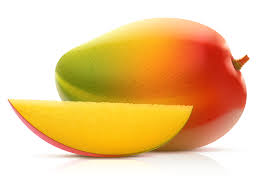Many nutritionists and food scientists believe the mango is "the king of the fruits." One thing is for sure, this nutritionally-rich fruit is one of the most popular, with unique flavor, fragrance, taste, and heath promoting qualities that put it on the list of "super fruits."
Mango fruit is rich in pre-biotic dietary fiber, vitamins, minerals, and poly-phenolic flavonoid antioxidant compounds. According to new research, mango protects against colon, breast, leukemia and prostate cancers.
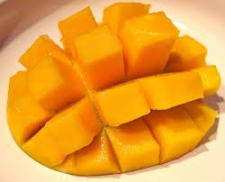
And mango is an excellent source of Vitamin-A and flavonoids such as beta-carotene, alpha-carotene, and beta-cryptoxanthin. About 1/2 cup of fresh fruit provides 765 mg or 25% of recommended daily levels of vitamin A. Together, these compounds are known to have antioxidant properties and are essential for vision. Vitamin A is also required for maintaining healthy mucus membranes and skin. Consumption of natural fruits rich in carotenes is known to protect the body from lung and oral cavity cancers.
Fresh mango is a good source of potassium. About 1/2 cup fruit provides 156 mg of potassium while just 2 mg of sodium. Potassium is an important component of cell and body fluids that helps controlling heart rate and blood pressure.
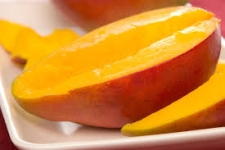 It is also a very good source of vitamin-B6 (pyridoxine), vitamin-C and vitamin-E. Consumption of foods rich in vitamin C helps the body develop resistance against infectious agents and scavenge harmful oxygen-free radicals. Vitamin B-6 or pyridoxine is required for GABA hormone production within the brain. It also controls homocystiene levels within the blood, which may otherwise be harmful to blood vessels resulting in CAD and stroke.
It is also a very good source of vitamin-B6 (pyridoxine), vitamin-C and vitamin-E. Consumption of foods rich in vitamin C helps the body develop resistance against infectious agents and scavenge harmful oxygen-free radicals. Vitamin B-6 or pyridoxine is required for GABA hormone production within the brain. It also controls homocystiene levels within the blood, which may otherwise be harmful to blood vessels resulting in CAD and stroke.
Further, it contains copper. Copper is a co-factor for many vital enzymes, including cytochrome, c-oxidase and superoxide dismutase (other minerals function as co-factors for this enzyme are manganese and zinc). Copper is also required for the production of red blood cells.
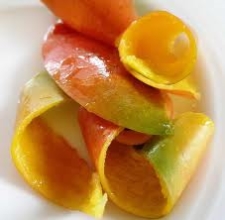 Additionally, mango peel is also rich in phytonutrients, such as pigment antioxidants like carotenoids and polyphenols. If you have a high-powered blender (Vitamix, Blendtec, etc.), a little mango peel will blend nicely with the flesh--you won't even know it's there.
Additionally, mango peel is also rich in phytonutrients, such as pigment antioxidants like carotenoids and polyphenols. If you have a high-powered blender (Vitamix, Blendtec, etc.), a little mango peel will blend nicely with the flesh--you won't even know it's there.
OK, all the scientific mumbo jumbo aside: Fresh mango fruit season begins in the month of May. Choose those with intact skin, without any bruises or cuts. Unripe mango can be kept at room temperature for few days, and to ripen, store in a paper bag. Store ripe mangoes in the refrigerator but never below 10° F. Allow the fruit to come to room temperature before serving, to get the full benefit of its unique taste and flavor.
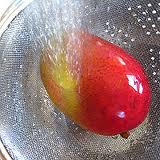 Wash the fruit in cold running water and pat the outer skin using a soft cloth. Mango should be eaten all alone without any additions to experience its rich flavor. Cutting the fruit can be tricky. Here's how the pros do it:
Wash the fruit in cold running water and pat the outer skin using a soft cloth. Mango should be eaten all alone without any additions to experience its rich flavor. Cutting the fruit can be tricky. Here's how the pros do it:
Cut the fruit lengthwise into three pieces in such a way that the middle portion consists of husky seed. Then, slice through the skin to separate the skin from the pulp. Chop pulp into desired sections.
Alternatively, using a sharp knife, cut through the flesh on either side of the central seed. This way, you get two big haves of a mango fruit. Then, take one-half and score the flesh in a horizontal and vertical pattern taking care not to cut deep through skin. Invert the whole half to push out the cubes as shown in this picture:
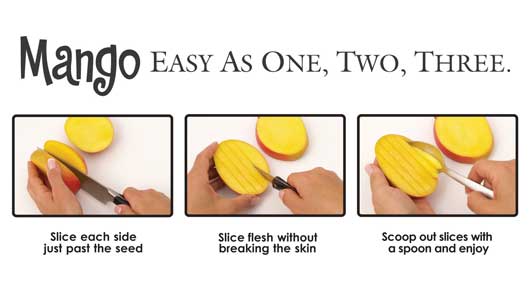
Now here's a recipe that is perfect for a summer meal. Serve this chilled soup as a dessert with or without a dollop of sweetened whipped cream and garnished with fresh mint. It also makes a superb base for a fresh fruit smoothie, by the way.
Mango Mango Soup
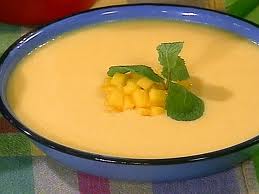
A healthy, easy, and refreshing soup perfect as a side dish or summer dessert.
Calories per serving: 92
2 1/2 cups freshly squeezed orange juice
2 cups flesh of mangos
2 cups diced mangos
Directions:
Recipe formatted with the Cook'n Recipe Software from DVO Enterprises.
- www.ppcgeeks.com
- www.fishcooking.about.com
- www.tropicalfloridagardens.com
- www.flixya.com
- www.parents.com
- www.foodnetwork.com
- www.mango.org

Alice Osborne
Weekly Newsletter Contributer since 2006

